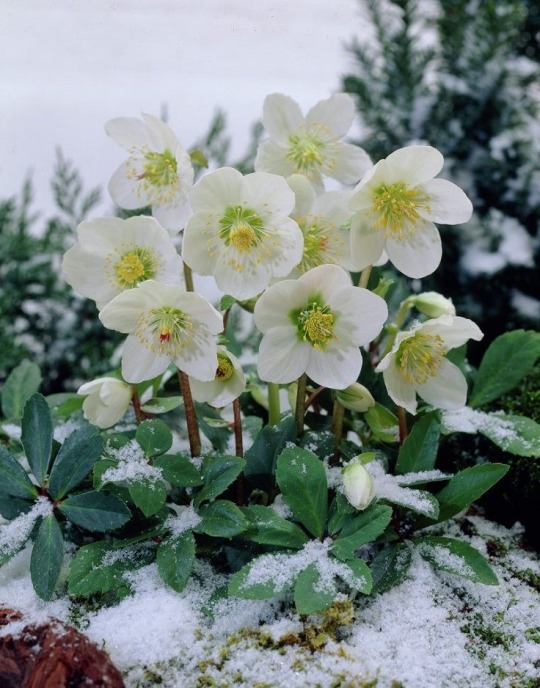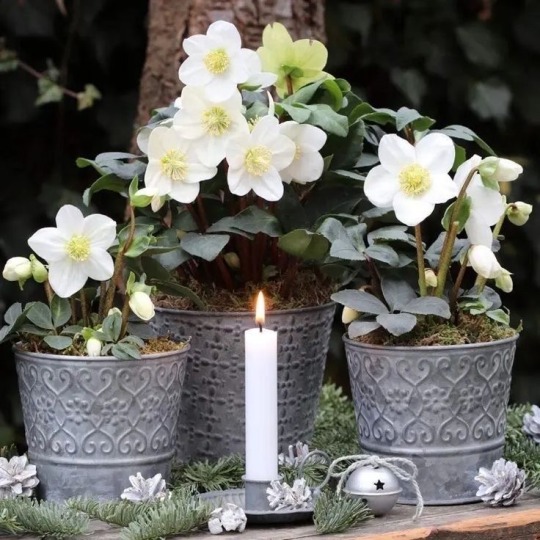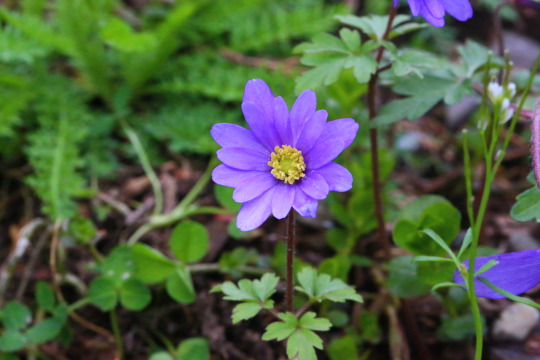#in the ranunculaceae family
Explore tagged Tumblr posts
Text
MONKSHOOD or WOLFSBANE, which is arguably one of the most poisonous plants around, is related to buttercups
#poisonous enough that simply touching the roots for long enough can cause symptoms#such as headaches#touching the sap and picking up food is supposedly enough to kill or rather can be but i need to double fact check this#i just think its an interesting fact. throwing a little plant fact out there for the undertale fans#i just have a lot of thoughts about buttercups being the plant of choice from a story standpoint#it fees so loaded what with how buttercups are so often associated with childhood games and whatnot#and obviously subverting that#it feels very heavy#anyways yeah! monkshood#in the ranunculaceae family#sorry for having autism about plants. outside/the woods is my special interest#and i will use any opportunity to mix special interests and talk about undertale too
2 notes
·
View notes
Text
the irony of the bisexual flowers
#BASICALLY i wanted to be fun and make werewolves weak to not just wolfsbane but also some related species#went up to the family#turns out a lot of ranunculaceae are perfect/bisexual flowers. and this is ironic to me so i'm incorporating it#it's probably not gonna be as Bad as wolfsbane but still a bit yikes#like a mild poison#tbf many members of this family are toxic anyway sooooo
4 notes
·
View notes
Text
Clematis Virginiana - Virgin's Bower
native
Buttercup Family (Ranunculaceae)


Notes: This guy is going crazy covering out front fence, covered in small white flowers. It's seed pods are also very visually interesting and stay throughout the winter as puffs. If any of it's vines touch soil it WILL try to set roots and make another plant, which happened this past year and we though "Sure this is fine" but it wasn't, dear reader, the plant is in control.
#Clematis Virginiana#Virgin's Bower#buttercup family#Ranunculaceae#White#July#In yard#I planted this#Planted 2023#Native#Illinois Native plant#Z19
1 note
·
View note
Text

see this is what i thought was going on
never forgiving you all for demonizing anemone at some point btw
#anemone wings of fire#i lowkey forgot wings of fire existed#i had to read someones tags to realize enamone is a dragon#and not a genus of flowering plants in the buttercup family ranunculaceae#justice for both the dragon and the plant guys!!!111!1!
10 notes
·
View notes
Text


The columbines (Aquilegia vulgaris) are fully awake! These guys are in the buttercup family, Ranunculaceae, which they also share with bleeding hearts and peonies.
26 notes
·
View notes
Text

芹葉飛燕草[Seribahiensō] Delphinium anthriscifolium
芹[Seri] : Japanese parsley, Oenanthe javanica
葉[-ba|Ha] : Leaf
飛燕[Hien] : Flying swallow; Kawasaki Ki-61
草[Sō] : Grass, herb
Native to China and it was introduced in the Meiji period(1868-1912.) It is a species that came in for ornamental purposes, escaped, and is now feral. It seems to prefer slightly moist, semi-shady places, and I have often seen it in recent years along roadsides in the woods. So is this one in the photo.
There is a close species called 飛燕草(D. ajacis,) which is native to Europe and was introduced around the same time and also became feral. The name 飛燕 is due to the shape of the flower, which resembles a flying swallow, and the name 芹葉 is due to the shape of the leaf, which resembles that of Seri.
They are both members of the buttercup family, Ranunculaceae, which has many poisonous species. Seribahiensō could be mistaken for Seri, which is edible, and care should be taken. https://www.youtube.com/watch?v=T19TIW_FLhs (homophone)
13 notes
·
View notes
Text
Passion Flower Clematis
Clematis florida is a species of flowering vine plant in the family Ranunculaceae, native to China. As the name suggests, its showy flowers bloom from May to September. It reached Japan in 1660s, called tessen from its Chinese name meaning 'iron wire' from the characteristic strong vine. Tessen can refer to a greater clematis varieties, crossed with endemic species like C. patens, C. terniflora and C. japonica.
8 notes
·
View notes
Text


Anemone are also a flower part of the Ranunculaceae family!!


Thinking heavily about these right now
89 notes
·
View notes
Text

I figured that for my first post, I should share one of my favorite flowers: the Upland Larkspur (Delphinium nuttallianum)!
Along with having an affinity for flowers I also like to read as much as I can about the biology of many of these plants and animals, and I'll try to post a summary of the cool (or what I think is cool lol) facts about the subject of my photography!
Upland Larkspur is a beautiful flower I shot while up in the Rocky Mountains, the plant itself is a member of the buttercup family (Ranunculaceae). The plant itself has a history as a cattle killer, it is rich in toxic alkaloids like Methyllycaconitine, which primarily affects the nervous system of the afflicted cattle.
The plants also grow in a wide range of elevations from the lowland meadows to higher up into the mountains (~11,000 ft.). On a little more positive note, the species act as a great early food source for many pollinators! As the flowers bloom from March to July, they often are the first flowers these pollinators rely on after a cold mountain winter. They also have a nectar spur they are specifically designed for long-tonged pollinators (Bees, Hummingbirds, etc) which is an example of convergent evolution with these pollinators.
#biology#photography#amatuer photography#wildflowers#nature photography#national parks#rocky mountian national park#larkspur#july#birth flower#outdoors#ethnobotany#plants#mountains#beautiful#floral#flowers
19 notes
·
View notes
Text


More Love in a mist... I am going to stick with that name. "Nigella damascena, love-in-a-mist, or devil in the bush, is an annual garden flowering plant, belonging to the buttercup family Ranunculaceae. It is native to southern Europe, north Africa and southwest Asia, where it is found on neglected, damp patches of land. Wikipedia"
#elementoftheeye#chambersburg#original photographer#original photograph#original photography#digital
14 notes
·
View notes
Text




Hellebore, a King of Poison Plants.
Hellebore and all its varieties are members of the Ranunculaceae family, making them related to Buttercups. All family members are poisonous to one degree or another, and poisoning by Hellebore is quite atrocious. Such poisoning can cause tinnitus, vertigo, stupor, as well as a feeling of suffocation, swelling of the tongue and throat, violent vomiting and a slowing of the heart rate until death by cardiac arrest. Touching just the juices of this plant cause irritation of the eyes and skin.
Hellebore has a rich folkloric, magickal, and medical history. This spellbinding flower is associated with the underworld, aiding in banishment and protection, and for many centuries serviced as a cure for madness and demonic possession. Ruled by both Saturn and Mars, Hellebore can have a very masculine energy. It is also associated with the element of water, which gives the plant very feminine qualities, acting as a portal to the underworld, the subconscious, and the lower realms. Hellebore is also thought to have been an ingredient in witches’ flying ointment.
((Fun Fact: These underworldly qualities are one of the reasons why my favorite zine, Hellebore Zine, is named after this transformative flower. If you’re interested in the occult and folk horror, you should check them out.))
In Christian folklore, Hellebore sprung up out of the snow from the tears of a young girl who could not bring a gift to the newly born Christ Child. Hellebore’s blooming time occurs between mid December to very early spring, popping up resiliently out of the frigid snow. For this reason Hellebore also represents transformation and resilience.
Of course, as always, please do not handle poisonous plants unless you are educated enough to do so. I always suggest meditating with the spirit of the plant and gain its benefits that way.
#hellebore#folklore#folk horror#artists on tumblr#illustration#witchcraft#witchblr#magick#herbology#baneful herbs#baneful magic#mythology
11 notes
·
View notes
Text

Aconite is a herbaceous perennial of the Ranunculaceae family renowned for its vivid blue to purple flowers. In Greek mythology, it is said to have arisen from the saliva of Cerberus, the three-headed dog guarding the gates of the Underworld. This connection with the afterlife gave rise to its common name, "wolfsbane," as it was believed to have the power to repel and even poison wolves and other predatory animals. Consequently, it was often used to protect livestock and deter these creatures.
In medieval Europe, it was closely associated with witches and was believed to have magical properties. It was thought to be used in potions and spells, contributing to its sinister reputation. Additionally, the association with monks and monastic robes led to the alternative name, "monkshood." Aconite should only be grown with caution although, in recent years, breeders have also developed less toxic varieties.
Aconite's pharmacological importance lies in its potent alkaloids, notably aconitine. It is highly toxic and can lead to severe cardiac and neurological effects if ingested or absorbed through the skin. Historically, aconite was used in minute doses as an analgesic, but this was risky due to its narrow therapeutic window. In contemporary medicine, aconitine is strictly controlled and rarely used. Some traditional medicine systems still incorporate it, but its main current usage is in homeopathic preparations.
135 notes
·
View notes
Text

Christmas Botanicals Series: Black Hellebore
Next up in the christmas botanicals series is the christmas rose, also known as black hellebore. Hellebore is a flowering perennial with evergreen leaves in the famously poisonous Ranunculaceae family which also contains aconites (wolfsbane), delphiniums, meadow rues, clematis species, and ranunculus (ranging from wild buttercups to ornamental flowers).
Hellebore contains saponins, cardiac glycosides, and other toxins. While ingestion of hellebore may not be deadly to humans, it is incredibly unpleasant. Symptoms include contact dermatitis, burning skin, burning of the mouth and throat, stomach pain, nausea, vomiting, diarrhea, dizziness, confusion, and irregular heartbeat.

Hellebore was one of the first documented chemical weapons used in warfare. The Greeks used the potently poisonous leaves to taint the entire water supply of the sacred city of Kirrha in 585 BCE to end a 10-year siege. It did not kill the residents but incapacitated them with vomiting and diarrhea while the Greek army invaded and slaughtered the entire population by the sword.
Hellebore has been venerated as a powerful plant by multiple ancient civilizations and was included in medical texts by the likes of Hippocrates and Theophrastus.
Black hellebore eventually became associated with christmas due to its evergreen leaves and naturally blooming in winter near the older date of christmas from the Julian calendar. Like mistletoe, the association is likely older than christianity and it was also brought in the home during the dark of winter to protect from evil spirits, ghosts, witches, and illness, but unlike mistletoe hanging in the roof rafters, hellebore was supposedly strewn on the ground with the rushes. Like hanging mistletoe, people in the British Isles and Europe continued the protective practice after converting to the new religion. Today the practice has changed to decorating with hellebore flowers for christmas.
#bane folk#poisonous plants#poison path#hellebore#black hellebore#helleborus niger#helleborus#christmas botanicals#christmas plants#christmas rose#plant folklore#ethnobotany#magical plants#magical herbs#green witchcraft#green witchery
41 notes
·
View notes
Text
Ranunculus abortivus - littleleaf buttercup
Native
Buttercup Family (Ranunculaceae)



Bloom: Started noticing in late march into April.
Notes: it's pretty dense in the area it's growing in, and the basal leaves remind me a lot of violet (which I also have growing everywhere)
LINKS:
https://www.illinoiswildflowers.info/weeds/plants/sf_buttercup.htm
https://en.wikipedia.org/wiki/Ranunculus_abortivus
https://www.inaturalist.org/taxa/126371/browse_photos
#Ranunculus Abortivus#Small-Yellow Buttercup#Crowsfoot#Native#In Yard#April#Ranunculaceae#Buttercup family#Z6#Z3#Z7#Z10#yellow#illinois native plant#volunteer
1 note
·
View note
Text



These Grecian Windflowers are new additions to the garden. I really like them and may plant more next fall. Hoping they spread and form a nice carpet of pretty blooms. The foliage is adorable too. The flowers close at dusk.
Anemonoides blanda, syn. Anemone blanda, the Balkan anemone, Grecian windflower, or winter windflower, is a species of flowering plant in the family Ranunculaceae. The species is native to southeastern Europe and the Middle East. The specific epithet blanda means "mild" or "charming".
Windflowers do best in areas that offer at least a half day of shade, but will grow well in full shade too. That makes these a spectacular bulb for woodland areas, under trees, along edging, or as a mass planting. They do best in rich, well-draining soil.
Uses.��Mix and mass for an excellent, early-blooming variety of colors for the rock garden, perennial border, wild garden or naturalized open woodland area. Excellent in large drifts under spring flowering trees. Good container plant.
Herbalists in the Middle Ages used A. blanda as treatment for gout and headaches. Due to their toxicity, they are no longer used as medications.
#garden#flowers#gardening#mygarden#spring#nature#anemone#grecian windflower#spring bulbs#anemone blanda#purple
26 notes
·
View notes
Text



The aquilegias (Aquilegia) are a genus of plants in the family Ranunculaceae. The 70 to 75 species are mainly found in the temperate regions of the northern half of the globe. Varieties of some Aquilegia species are used as ornamental plants.
15 notes
·
View notes